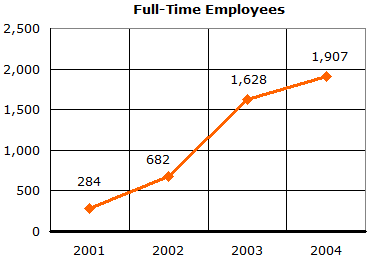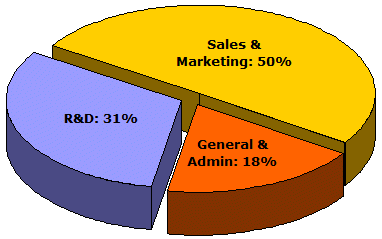Google IPO To Happen, Files For Public Offering
As many expected, Google filed to go public today. In this story, we provide a breakdown of facts and figures from the financial information the company has now published for the first time.
As many expected, Google filed to go public today. In this story, we provide a breakdown of facts and figures from the financial information the company has now published for the first time.
As many expected, Google filed to go public today. Below, Search Engine Watch provides a highlight of interesting information out of the filing. For more traditional coverage, see the story from our sister site ClickZ: Google Files For $2.7B Public Offering.
Scroll down to read or jump to:
Google Revenues – Ad Revenues Up Close
Google Worries – Google Employee Facts
Google Acquisitions – Other Google Facts
News Coverage & Other Resources
Google is on track to earn over US $1 billion in net revenues in 2004, according to the filing, earning over $250 million in profit. Here’s a look at net income, expense and profit (income/loss figures) based on Google’s filing:

Note that figures for 1999 through 2003 are based on what Google reported for a full year. Figures for 2004 are a simple Search Engine Watch projection, created by multiplying Google’s first quarter figures by four. The actually earnings could obviously be much higher or lower than projected, depending on a variety of factors.
Some additional revenue related highlights, from the filing:
The vast majority of Google’s revenue comes from advertising. Only a tiny slice comes from other sources, such as enterprise search services, web search services and other products:

Figures shown are for the full years of 2001, 2002, 2003 and for the first three months of 2004, from the filing.
Where is that advertising income earned? Google operates its own web sites, plus it distributes ads to partner web sites (the filing calls these partners the Google Network). This dual distribution has been well-known, but what hasn’t been known was how much revenue the partners added to Google. As it turns out, relatively little, though that trend is rapidly reversing:

Figures shown are for the full years of 2001, 2002, 2003 and for the first three months of 2004, from the filing.
What’s going on? In a word (well, two): Google AdSense. Google gained no major portal partners or other keyword-driven ad distribution deals in that might have accounted for such a growth in revenue from on the network side. But in 2003, it launched its AdSense contextual ad program and then greatly expanded AdSense.
AdSense placements are almost certainly the reason why Google has seen network-derived ad revenue rise so sharply. It also shows Google becoming increasingly tied to what happens beyond the borders of its own web sites to earn money.
Also interesting is a portion of the filing the admits in some cases, Google may enter into agreements where it pays a network member more than they have earned for AdSense placements, because of its inability to predict accurately how much earnings will be:
Due to intense competition for Google Network members and our limited ability to accurately forecast the number of paid clicks that will result, we expect that we will enter into AdSense agreements from time to time under which we will make payments to the Google Network member exceeding the revenue we recognize from the agreement.
Google’s filing is full of many standard things that investors might be warned about. The company even addresses the issue of privacy concerns about its Gmail system or the controversy over anti-Semitic site ranking at the top of its results for the word “jew” might hurt its brand. Here are a few things that particularly caught my eye among the many investor warnings:
Google has nearly 2,000 full-time employees at the moment and a “significant number” of temporary employees. Figures over time:

Most of these employees are involved in sales and marketing, but a healthy chunk focus on research and development. Employee classification, as of March 31, 2004:

Google cofounder and president of technology Sergey Brin is the youngest of Google’s executive officers and directors. At 30, he just beats Google’s other cofounder and president of products, Larry Page. The oldest of this group is Wayne Rosing, Google’s vice president of engineering. The entire group has a median age of 48.
Google bought Applied Semantics in April 2003 for $102 million, $41.5 million of which was in cash.
Google also says that in 2003, it purchased three other companies for a total of $15 million, only $1.5 million of which was in cash.
The companies aren’t named. But Google bought Blogger in February 2003, acquired Kaltix in September 2003 and purchased Sprinks in October 2003. These are almost certainly the “three” companies referenced.
PageRank, as I’ve written many times before, is not the Google ranking algorithm. Instead, it’s just one of many different factors. However, it is the most known and a key element of what Google does.
Stanford University, where PageRank was developed by Google’s cofounders, owns the patent on PageRank. However, the filing reveals that Google has been granted a perpetual license and that in October 2003, it extended an agreement giving it exclusivity to PageRank through 2011. So speculation that issues over the rights to PageRank might complicate the Google IPO don’t appear to be a problem.
Google notes there’s a lawsuit against it by Yahoo over patents held by Yahoo-owned Overture relating to paid listings. This dispute was well-known. What’s surprising, if I read the filing correctly, is that Google does not consider several lawsuits involving trademarks and keyword-linked ads to be significant.
Writes Google, after discussing the Overture case:
Currently, there is no other significant litigation pending against the Company other than as disclosed in the paragraph above.